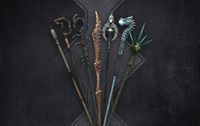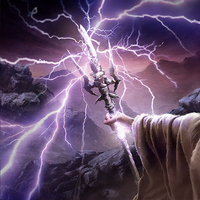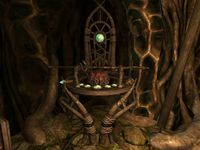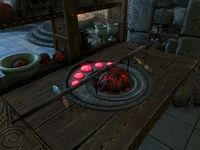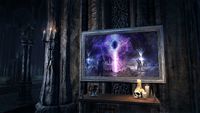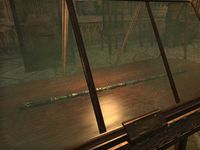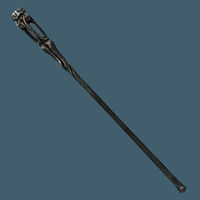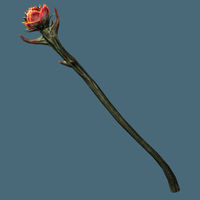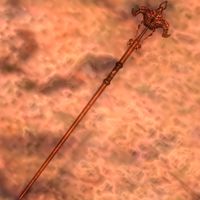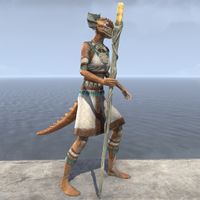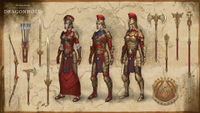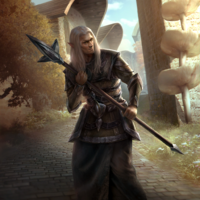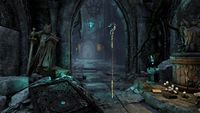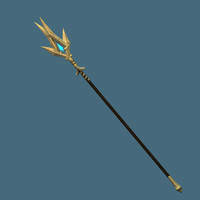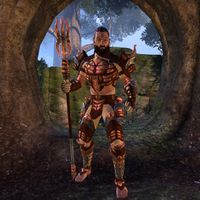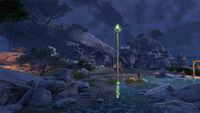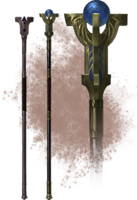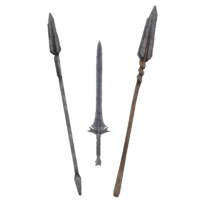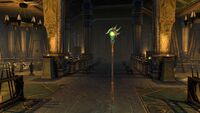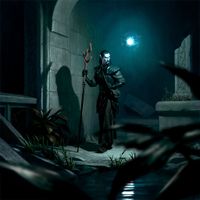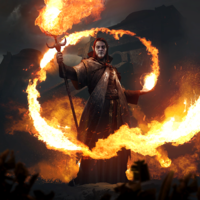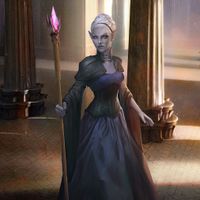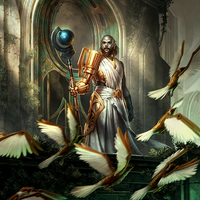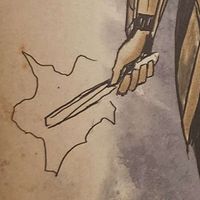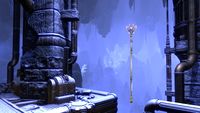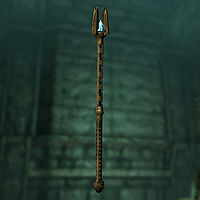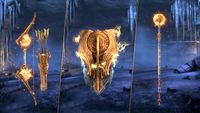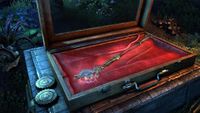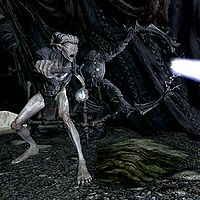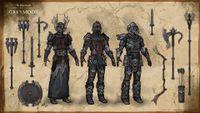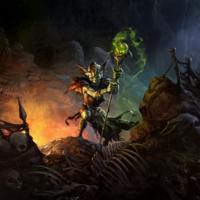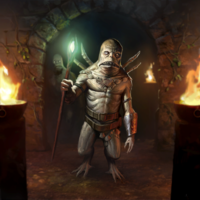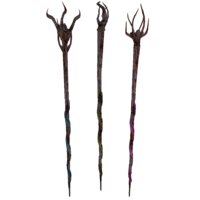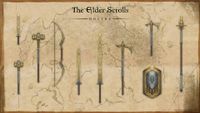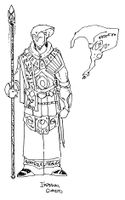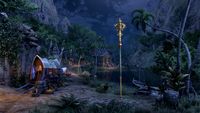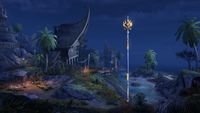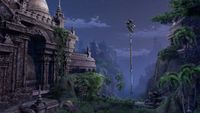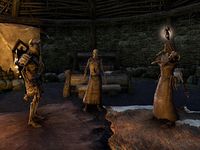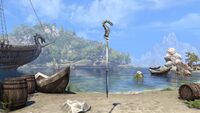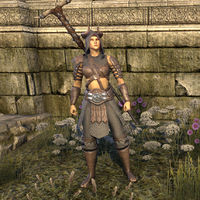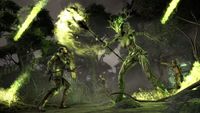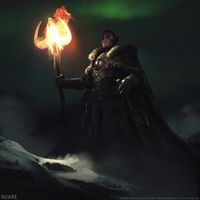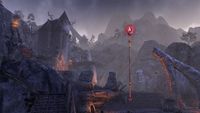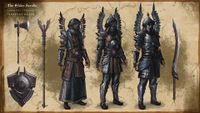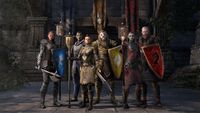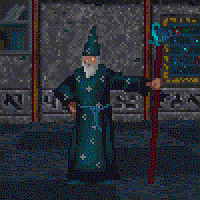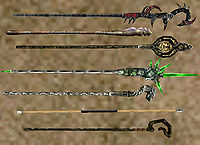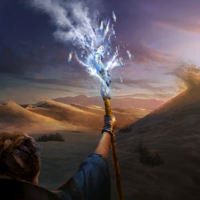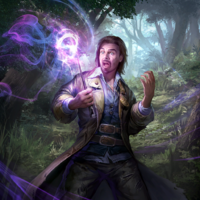Lore:Staff
Staves (or staffs) are implements and weapons frequently wielded by practitioners of magic.[1] Staves may be imbued with individual enchantments and used regardless of the wielder's magical abilities.[2][3] They may also serve as focal points for casting spells to assist traditional spellcasting, acting as a focus of power rather than its source.[4][5] Various types of staves can be crafted and enchanted to accommodate different forms of magic. Staves designed for casting spells exist across all schools of magic, including restoration, destruction, illusion, conjuration, alteration, thaumaturgy, or mysticism.[nb 1] Additionally, they represent a mage's status and hold considerable symbolic significance,[6][7] evoking the qualities of leadership and authority.[8]
In addition to staves, other tools serve similar purposes, such as smaller wands,[9][10] which can also function as focal points for spells, or be enchanted themselves.[11][12] Rods are utilized for divination,[13][14] although they can also serve as tools for training in spellcasting.[15] They also have more specific uses. Similar to staves and wands, rods can also bear singular enchantments.[16][17] Some rods are designed to control fire and serve as ceremonial tools.[18][19] Additionally, some are used to channel magic in similar manner to staves.[20][21] The tools utilized by the Dwemer to command their animunculi are often referred to as rods.[22][23]
Wands and rods are categorized as distinct implements from staves, forming part of the training equipment for Shad Astula adepts.[15] Other types of items are also utilized as aids for channeling magic, such as gloves for members of the Psijic Order,[24] or tomes commonly used by Arcanists.[25]
Staves are also employed in close-quarters combat.[1] This is often the case when spellcasters find themselves in need to fight at short range.[26][27] In such scenarios, they function as blunt weapons.[28][29] On occasion, they are employed for defensive purposes.[30] Some staves possess features enabling them to function to some degree as melee weapons. Depending on their design, staves provide a diverse range of uses, doubling as half-pikes, spears, harpoons, pole-axes, or tridents when the situation demands.[nb 2] A staff can also double as a barrier when on sentry duty,[31] or a pry bar.[32] Some staves also serve as crosiers,[33][34] often having ceremonial functions in the societies where they are used.[35] Some staves serve as symbols of office, like the Royal Staff of Anequina, which is used by the Khajiiti monarchs of Anequina,[36] or Fahara'jad's Rod, a royal Redguard staff. Replicas of Fahara'jad's Rod are often given as gifts by Forebear nobles to their children.[37]
Enchantment[edit]
Enchanting staves is regarded as a challenging endeavor.[2] The Staff Enchanter serves as an arcane implement, distinct yet similar to the Arcane Enchanter used in general enchanting practices.[38] Azra Nightwielder, the original shadowmage, and Neloth of House Telvanni were both renowned for their mastery in staff enchanting. Azra Nightwielder pioneered the field of staff enchantment. However, his techniques eventually became regarded as rudimentary by Fourth Era standards, though he remains esteemed as a genius of his time. Neloth of House Telvanni extensively studies Azra's creations.[39] However, this practice is not uncommon among mages both within,[2] and outside the Mages Guild.[12][40]
Neloth of House Telvanni asserted that he was the creator of the Staff Enchanter, or stated that its creation required grand wizardry,[39] although other variations of staff enchanters exist.[38] Additionally, the art of enchanting staves through alternative methods, such as the use of runestones and glyphs, is also practiced.[5][40] Heart stones are employed in the enchantment method requiring Neloth's Staff Enchanter,[38] yet there are other methods of enchanting staves that do not necessitate them.[2][40]
- →For more detailed information about enchanting, staves included, see: Enchanting
Religion[edit]
Gods such as Magnus, Myn and Zisa are often associated with staves or wands. In Akaviri and Rim-Men traditions, Myn wields a mighty staff, while Zisa waves a graceful wand.[41][42] Magnus the god of magic, is occasionally symbolized by a staff.[41] The Priory of the Golden Staff was an order dedicated to Magnus,[43] and he is closely tied to the Staff of Magnus, a powerful artifact.[44] The Mage constellation and Celestial are also associated with staves and rods.[45] The Celestial Mage's staff was a grand celestial obelisk in Craglorn.[46] Certain staves and wands are associated with various Daedric Princes, such as Sanguine,[47] Sheogorath,[48] Vaermina,[49] Ithelia,[50][51] and Hircine,[52] as well as other gods such as Baan Dar,[53][54] saints and other significant figures in various faiths, such as Saint Llothis and the Druid King.[34][55] Within the Altmeri religion, both Syrabane and Xarxes are depicted in statuary or described in the literature as wielding staves.[56][57] Ius is depicted wielding a rod.[58] Some staves bear the silver and golden symbols of Mara and had pearl decorations.[59] In Redguard belief, Ruptga fought Sep wielding a staff.[60]
Unique Staves[edit]
Several unique staves and wands are regarded as legendary artifacts, including the Wand of Bone,[52] the Staff of Towers,[61] and numerous others.[48]
Staves:
- Arm of the Moon
- Arm of the Sun
- Azra's Staffs
- Crosier of St. Llothis
- Druid King's Staff
- Hrormir's Icestaff
- Itinerant Staff
- Miraak's Staff
- Rod of Kravari
- Rootmender's Staff
- Sanguine Rose
- Skull of Corruption
- Staff of Chaos
- Staff of Hasedoki
- Staff of Indarys
- Staff of Magnus
- Staff of Many Paths
- Staff of Sheogorath
- Staff of the Everscamp
- Staff of Towers
- Staff of Worms
- Sunna'rah
- Ul'Vor Staff
- Unraveling Staff
- Wabbajack
Wands:
- →For more detailed information about unique items, staves included, see: Artifacts
Culture[edit]
Numerous Tamrielic cultures employ unique methods for crafting and enchanting staves.[62] Various cultures utilize different materials for their spellcasting staves, with commonly known options including maple, oak, ash, or elm.[4]
Akaviri[edit]
Akaviri staves hold great value among their mages, often adorned with splendid and lavish decorations. Many featured gold leaf accents and impressive red gems. The hafts, made from a dense and flexible wood not found in Tamriel, are capable of deflecting even the force of a great axe.[63] Some staves are embellished with metal rings affixed to their heads, producing a melodious and fearsome sound as the Akaviri moved—an eerie song that sent chills down one's spine. The purpose of these rings has been questioned, as the Akaviri of old were believed to be too practical to indulge in purely stylistic choices.[64][65] Factions inspired by the Akaviri, like the Dragonguard and Blades, were recognized for their unique style. They continued the tradition of using red gems and intricate decorations on their staves.[66] Some likened these staves to storytellers, portraying a spell as a tale and the staff as the storyteller itself.[67] While the Akaviri may no longer be present in Tamriel, their descendants persist, and their cultural legacy endures. Charged and storm staves they left behind can still be found in Tamriel, with some being safeguarded in Dragonguard vaults.[68]
Akaviri deities Myn and Zisa were linked to a powerful staff and an elegant wand, respectively.[42]
Altmer[edit]
The Altmer are renowned for their spellcasters,[69] with two of their deities, Xarxes and Syrabane, often depicted wielding staves.[56][57]
Sapiarch staves are adorned with upper ends that echo the shape of the symbolic home of the Altmer, the Crystal Tower. Atop these staves are Magicka-flow brackets holding a finial Nirn-globe, symbolizing their global leadership in all arts of scholarship and knowledge. The sphere also acts as a focusing lens for magical projection.[70] While some accounts in historical fiction suggest that Sapiarchs only carry a staff and a dagger,[71] they have been observed utilizing various metal armaments.[70]
The staves of the Welkynars, the knightly order of Cloudrest, are topped with stylized gryphon wings, resembling the wings of a knight's flying mount during a power dive. This shape also evokes the focus of a spellcaster's will. The long ash-wood haft of these staves typically ends in a sharp ferrule.[72]
Members of the Divine Prosecution and soldiers of the Aldmeri Dominion are known for their special designs of staves, each reflecting their respective organizations' values and purposes.[73][74]
Clan Direnni is famous for its unique armaments, including staves designed by Raven Direnni herself. These staves feature two gracefully curved blades that come to points over a middle prong, giving the impression that the staff itself is ready to take flight. The metal on the staff's end also aids in navigating rough terrain.[75]
Certain Altmer staves are crafted from wood harvested from Silatar Island.[76]
Some Altmeri rods are designed to control fire and are typically used to maintain flames in Altmeri shrines as ceremonial tools.[18][19]
Argonian[edit]
During ancient times, staves held a significant role as instruments of the Sithis priesthood. These bronze rods were adorned with icons and symbols of the Great Serpent, the deity to whom the priests offered sacrifices. Some staves even featured razor-sharp, glass teeth designed for bloodshed during various ceremonies. The historical evidence suggests that Sithis played a more prominent role in ancient Argonian worship compared to the present day, especially among most tribes.[77] The Rootmender's Staff is an ancient Argonian artifact.[78]
Modern Argonian staff designs, much like their ancient counterparts, vary based on the tribe. The staff of the Dead-Water Tribe, for example, is as formidable as their blades. Its amber gem is infused with the sap of the Hist, absorbing its power. These staves are crafted using the bones of fallen mages, a process believed to transfer their magical essence to the weapon.[79] Some of these staves were infused with with voriplasm essence.[80] The staves of the Sul-Xan tribe feature large spikes that provide additional advantages in melee combat. The heads of these staves are adorned with jade and a disturbing visage, similar to the masks worn by the tribe. There was speculation that these depictions may represent a revered ancestor.[81] Xit-Xaht of Mazzatun also had their unique staves. Distinguishing between a ceremonial staff and a battle staff among the Mazzatun inhabitants was challenging. They are often crafted from fallen branches of their tribe's Hist tree. The heads of these staves are adorned with animal and other skulls, each chosen for its significance to the wielder.[82]
Staves used by Keshu's forces, the Black Fin Legion, showcase an Imperial influence in their design. The challenging terrain and close-quarters nature of skirmishes in the Black Marsh necessitate a dual-purpose approach for every legionnaire, whether archer, footsoldier, or spellcaster. To cater to close combat situations, Black-Fin Legion staves are equipped with lead striking heads and robust brass hafts, ensuring spellcasters are prepared for melee encounters.[83]
Ayleid[edit]
Ayleids were also renowned for their staves, with one of the most well-known being the Staff of Towers crafted by the arch-mage Anumaril.[84] Another notable Ayleid staff, the Staff of Ehlno Ede, was wielded by the lich Norion the Undying. It was known for its potent abilities to drain stamina and unleash powerful lightning enchantments.[85] The Staff of Nenalata is another notable Ayleid staff.[86][87] Certain ancient Ayleid staves were known to cause their wielders to hear faint, beautiful singing.[88]
Bosmer[edit]
Wood Elves favor natural motifs, stemming from their reverence for Y'ffre.[89] They are known to use Y'ffre-Bound staves, visibly graced by the God of Song and Forest.[90] The Stags of Z'en, a Bosmeri order, utilize staves that reflect the Green's sublime power with fearsome mandibles and sharpened leaf motifs. Any spell channeled through such a weapon carries the full blessing of Z'en. These staves ensured that their wielders repay bloodshed in kind.[91] Some Bosmeri staves, referred to as Spiderstaves, were covered in sticky coatings,[92] while others were fashioned to emanate despair.[93] Vinedusk Rangers also employed staves.[94] Certain Bosmeri spell-eaters, including Celedith, were noted as staff wielders during the Imperial invasion of Valenwood in 1E 2712.[95][96]
Bosmer are also known to use and trade finger-bone charms made from the still-magically-charged hands of their deceased wizards for spellcraft.[97] Some bones, such as femur bones of Spinners are occasionally fashioned into staves.[98]
Rindir was a renowned Bosmer staff seller, acclaimed for offering the finest staves in the entire Imperial City during the late Third Era. Many mages vouched for the quality of the staves he sold.[99]
Changelings also wielded staves in battle.[100][101]
Breton[edit]
Staves are commonly used by Breton mages throughout High Rock.[102] Bretons, regardless of their city,[103] druidic,[104] or wyrd origins, commonly utilize staves.[105] Breton weaponry, including staves, draws inspiration from their Elven ancestry. These weapons are characterized by their elegance and beauty, while still possessing undeniable lethality.[106] Early Breton mages crafted their staves from the wood of the Wyrd Tree, a legendary plant with roots said to reach into the bones of the world. These staves are noted for their exceptional mana manipulation abilities, surpassing those made by the Sapiarchs.[107]
The details about staves of the Wyrd are rare, with only hints of avian imagery among the staves of the Glenmoril Wyrd.[105] However, druids are recognized for utilizing a diverse array of staff styles, each associated with their respective circle. Druids as a whole believe that even after being cut and hewn, the wood they use remains alive and aware, evident in their staves which rhythmically thrum as if still trying to grow, breathe, and draw water from the earth beneath. Some druidic staves were adorned with stone designs, reflecting their connection to nature and the earth.[108] Specifically, Druids of the Firesong circle favor skarn, carving their heads with the emblem of the ever-watchful gryphon, channeling elemental ferocity against their foes. They take great pride in their staves, considering them exemplary. Further details regarding differences in staves among the other two circles are scarce.[104][109]
City Bretons of Systes, particularly from Gonfalon Bay's Guard, utilize staves with a unique double-pointed design as a practical deterrent against attackers. The double points serve as a menacing feature, amplified by the crackling of lightning or fire for added intimidation.[103] Breton knighthood frequently included staff-wielding knights, known as spellknights, alongside traditional warriors. The Ascendant Order equips its members with sturdy steel rods featuring dark leather grips, suitable for dealing deadly blows in melee combat when needed. Battlemages of the Order of the Silver Rose rely on silvered-steel staves as their primary tool, enabling them to endure melee combat and deliver potent strikes against mortal and Daedra-tainted adversaries. The silhouette of a rosebud on these staves symbolizes the latent magical potential awaiting manifestation. Members of the Oaken Order, known for their preference for magical combat, possess uniquely designed staves tailored to their distinctive style.[110][26] Individual noble houses occasionally developed their own unique designs for staves, as seen with House Mornard.[111]
Daedra[edit]
Many Daedric races make use of staves for both offense and defense.[112] The Forces of Order equip their mortal warpriests with crystallise staves capable of harnessing powerful shock magic, and Grummite magi have been known to attach similar crystals to their own staves for the same purpose.[113] Daedric staves are a rare sight on Tamriel, but their superior craft also makes them among the most powerful.[114]
Similar to other bound weapons, staves can be conjured from Oblivion.[115]
Dunmer[edit]
The Dunmer are renowned for their rich magical culture, a tradition that extended back to their predecessors, the Chimer, who also used staves and wands.[116][117] Different groups within Dunmer society, including the various Great Houses,[30][118] Sotha Sil's disciples, known as the Apostles,[119] members of diverse Dunmeri organizations and orders devoted to religion,[31], knighthood,[120] and legal assasination,[121] as well as tribal Ashlanders, each have their own distinct styles when it came to crafting of staves.[35] Dunmeri staves exhibit elegance but are reflective of far more harsh and rigid environments than those of Altmer. Dunmeri artifice draws inspiration from the curved and spiky forms of the carapaces of the giant insects that inhabit Morrowind. While elegant, these staves also evoke a sense of fear and intimidation.[122] Some staves are crafted from bonemold,[123] while others utilize remnants of dreugh, malachite, silver, ebony, wood, or steel.[124]
House Hlaalu, renowned for their mercantile endeavors, extended their symbolism to their staves as well. A Hlaalu mage's spell staff features a finial shaped like the House's double-scales symbol, proudly showcasing the wielder's affiliation with the world-famous Morrowind mercantile masters. The foot of the staff is sheathed in metal with a heavy ferrule, capable of serving as defensive weaponry when necessary.[30] Queen Barenziah wielded a staff adorned with an ornate jewel on its headpiece, similar in design to the jewels of her crown.[125][126]
While predominantly warriors, House Redoran also houses mages.[127][128] Their spell staves sport finials resembling the shalk-mandible horns of their helmets, designed to detach easily during close combat and reattach after battle without damage.[118]
House Telvanni, dedicated to magical research, boasts powerful mages. Their spell staves feature finials adorned with the House symbol crafted in gilded silver, ensuring that Telvanni wizards are unmistakably identified, even when not wearing their uniform.[129] Dunmer of Bal Sunnar, adhering to the guidance of Matriarch Lladi Telvanni, ensured that the staves carried by their mages bore a marking resembling a star breaking through the night, fastened with gold. The head of the staff is split like two arrowheads, symbolizing their Matriarch's departure and her blessed return, united in unwavering commitment.[130] Silver Staves of Peace serve as the traditional patron's gifts to their protege within House Telvanni, often associated with promotion to the rank of Mouth.[131][132]
Less is known about the staves of House Indoril,[133] House Dres,[134] and the Sixth House, House Dagoth, but all three houses had mages who utilized staves.[135][136]
The Ashlanders used spell staves not only as a magical weapons but also as a ceremonial crosiers, laden with symbolism meaningful to their culture. Each staff is adorned with one, two, or even three symbols of the Good Daedra, encircled by a double crescent of chitin and bone. The haft of the staff terminates in a pointed ferrule akin to that of a mace.[35] Ashkan Conoon Chodala wielded and utilized Sunna'rah to temporarily drain the divine powers of the Tribunal.[137][138]
Staves were considered among the preferred weapons of the Tribunal Temple,[139] with some, like the Crosier of St. Llothis, being associated with significant figures in the faith.[34] Dunmer religious texts occasionally make reference to staves. For instance, Sermon 17 of the Thirty-Six Lessons of Vivec recounts an instance where Nerevar attempted to fashion a staff from eight spokes. Vivec responded by stating that it was not the appropriate time for such an endeavor and asserted that he himself was the wheel.[140] The weaponry of the Buoyant Armigers holds a profound connection to the content of Vivec's Sermons. Inspired by passages from Sermon 17th, their staves are designed to be singular in shaft and to embody contradictions in their very essence.[120] The design of Buoyant Armigers' staves in Necrom differed from those found in Vvardenfell.[141] The Ordinators also employed staves in their duties. The staff of a Militant Ordinator of the Order of War spell-caster is topped with dual sweeping crests resembling those on their helms, pointed and parallel, guiding their righteous magical onslaughts. They also served as a horizontal barrier to entry when used by sentries guarding doors or portals.[31] The Order of Doctrine, known for their distinctive style, arms their militant scholars with staves that both intimidate and silence those who spread false teachings.[142] Dunmeri militias were also known to utilize staves in their operations.[143] The Morag Tong was not renowned for its spellcasters, as there were only a handful within the organization. Rarely, the Tong would utilize staves with finials resembling heavy brass Dwarven fish, although little else is known about their designs.[121]
Sotha Sil initially drew inspiration for his Clockwork City technology from the Dwemer, but over time, he developed a more distinctive style. Staves associated with decommissioned factotums of the D-series were thought to be most effective with a focal finial made from the soul gem bezel setting of a spider construct, be it ancient or modern. Surprisingly, the gripping element from a bread slice carbonizer was found to work nearly as effectively.[144] More modern designs, used by the Apostles of Sotha Sil from the 2nd era up until the 4th,[145] featured a perfect brass sphere as the focus, similar to their maces. However, unlike the Apostle mace, this sphere rotates on a central axle of the staff, enhancing the balance and reflecting the perfection of Lord Seht. Additionally, it was noted that spinning it provides hours of pleasant idle distraction for children and pets.[119]
Dwemer[edit]
Even the most intricate Dwarven staves exude practical appearance. Crafted from a close-grained material resembling wood but not quite, the haft is encircled by bands of Dwarven metal. The finials, typically circular or fan-shaped, are modest in size.[146] Although there are no records indicating Dwarves worked with wood, their staves are fashioned from a lightweight yet durable metal alloy. The headpieces often resemble small mechanisms, though their actual function in enhancing Dwarven staves remains a mystery.[147] Designs varied depending on the region and settlement, such as those found in Rkindaleft,[148] Rkugamz, Vault of Mhuvnak,[149] or Arkthzand.[147]
The Dwemer employed a variety of tools, often referred to as rods, to command their animunculi.[22][23] There were Dwarven staves that could conjure their constructs from other places, containing aetherium.[150] Some other Dwarven staves, particularly those of Arkthzand, also contained this material.[147][151] Dwarven Architons, a type of Dwarven construct, were known to wield such staves.[152] Some Dwarven staves were also utilized for manipulating tonal devices.[153]
The intricate designs of the Dwarves served as inspiration for various cultures,[154] influencing their staff-making practices. This influence can be observed among the Dunmer,[144][119] Reachfolk,[155] and even certain Riekling,[156] and Daedric designs, such as those associated with the Maelstrom of Fa-Nuit-Hen.[157] The Undaunted also repurposed certain Dwemeri designs, integrating them into their own equipment and weaponry, staves included.[158][149]
Falmer[edit]
Despite the rich magical culture of the Snow Elves, little is known about their staves before their corruption. The Betrayed are known fashion their staves from chaurus chitin.[159][160] Falmer shamans were known to use them in combat.[161][162]
Giant[edit]
While some scholars mistakenly believed that Sea Giants eschewed magic,[163] they are, in fact, adept mages, particularly skilled in water,[164] lightning,[165] fire,[166] restoration,[167] and conjuration magic.[168] Their strong affinity for bone is evident in the decoration of their staves. Small animal skulls often adorn the tops, while larger bone pieces are carved into thin sails, serving to spread fear and intimidation to those unfortunate enough to incur the wielder's wrath.[163]
Giants, the land-dwelling relatives of Sea Giants, although possessing some magical abilities, were not documented to use staves.[169]
Goblin-ken[edit]
Goblin shamans,[170] and witches are known to wield staves,[171][172] including the Goblin Totem Staff. This specific type of staff is commonly found in various Goblin hideouts. Shamans, serving as spiritual leaders, were responsible for guarding sacred totem staves of their tribes.[173][174] Some of these totem staves were topped with the mummified heads of juvenile Goblins.[175] Occasionally, goblin totem staves were wielded by their chieftains and adorned with feather and bone decorations.[176][177]
The Rieklings of the Coldsnap Tribe were known to use staves, with their mystics replacing the fir branches of these staves with salvaged rods from the Dwarven ruin of Frostvault. It remains unclear whether the utilization of Dwarven metal has improved their magical abilities, but the staves crafted with it were more effective as melee weapons.[156]
Riekrs also use staves and totems, with some of them engaging in magic, including menders and chieftains like Chief Iziku of Wrothgar.[178][179]
Grummite[edit]
Grummites, known for their proficiency in magic, are reputed to be cunning craftsmen capable of creating staves.[180][181] Within Xedilian, Grummite shamans even went so far as to affix Focus Crystals to their staves, harnessing the crystals' inherent lightning magic.[182]
Imperial[edit]
Magical support troops in the Legions were known to undergo training with the staff.[1] The Ivory Brigade of Blackwood also utilized staves. Priests and mages played a crucial role within the ranks of the Ivory Brigade, and it was deemed essential for spellcasters to be as well-equipped as the footsoldiers. An Ivory Brigade staff typically consisted of a lightweight yet sturdy brass rod with grips made from forest-green leather. The head of the staff was fashioned into a simple and utilitarian triangular steel crozier.[33]
Staves of the Imperial House Hexos feature the Imperial diamond atop a shaft crafted from lightweight metal alloys. Many wooden staves are not suited to withstand the harsh conditions of hostile planes.[183]
The Imperial Order of the Hour, dedicated to the worship of Akatosh, was renowned for staves adorned with finials resembling great hourglasses crowned with the wings of the Dragon God of Time. The ferrule at the end of the haft is often a pointed steel spike, while the haft itself boasts designs reminiscent of the swirling mists of time.[184]
Khajiit[edit]
Khajiit are known to craft exquisitely balanced and durable staves using materials such as moonstone.[185] Staves used by Khajiit of Anequina serve dual purposes as both melee weapons and tools for spellcasting. In the hands of a mage, these elegant staves are capable of producing potent spells and evocations, while in the paws of a claw-dancer, they can deliver swift and lethal strikes.[186] In Pelletine, staves are known for their martial refinement, crafted from stout Tenmar oak for the haft and adorned with elaborate bronze headpieces resembling king's crowns, embellished with fragile lotus blossoms and grand chandeliers.[187] The Baandari, members of a nomadic Khajiiti culture, also have their own distinctive style of staves.[188]
Some Khajiiti staves were formed from the essence of planar dream-stuff.[189]
Clergy of Alkosh from Sunspire preferred cedarwood walking sticks and mighty staves, distinguished by precious metal disks bearing the phases of Jone and Jode, imbued with great power within their headpieces.[190] Hollowfang Khajiit embellished their staves with symbols of wings, flames, and claws as reminders of Dragon prowess. Followers of the New Moon Cult depicted Dragon's terrible image on the heads of their staves, crafted from dark ironwood and embedded with aeonstones to amplify spellcraft.[191]
Dro-m'Athra, corrupted Khajiit spirits, were known to wield staves adorned with two down-turned waning crescents forming the head, while above them rested the crescent Ghost Moon, poised to unleash spells of Destruction.[192]
-
Pellitine outlaw staff
-
New Moon Cult staff
Kothringi[edit]
Little is known about Kothringi staves, except for the fact that they existed and were used by their shamans.[193] They were also known to craft other types of magically imbued items.[194][195]
Maormer[edit]
The Maormer have been known to extensively use lightning staves in their war efforts.[196][197] The finial atop a Pyandonean staff is sculpted in the shape of a sea serpent, made of orgnium, the same light metal used in Sea Elven armor. While it was unclear whether they are typically imbued with magical properties to aid in spell focusing, it was likely.[198]
Taleria of the Dreadsails held her mages, especially the Sea Mages, to high standards. She mandated that any Dreadsail with magical talent must master a staff similar to her own, for both casting and as a harpoon. The three-pronged, barbed end could securely lodge in a whale or a foe sailor.[199] While not inherently tied to Maormer culture, certain items in their arsenal, including staves, were crafted from frog-metal. Such staves were light and featured dark orange fins that reach toward the sky, resembling a creature descending upon its prey in the salty depths. The slender metal of the staff was easy to wield and not cumbersome. The bottom section of the staff was designed to resemble a lurking octopus, providing balancing weight.[200][201]
Minotaur[edit]
Minotaurs are known to use magic and staves.[202] Minotaur staves were believed to be commonly adorned with a pair of broad horns, while the haft below the head was wrapped in metal, enabling the staff to function as both a defensive tool for parrying and a means of disciplinary action for transgressors.[203]
Nature Spirit[edit]
Certain Spriggans wield staves.[204] Some are crafted from branches, radiating with green energy for the purpose of spellcasting. Specific details about these staves remain unknown.[205][206]
It remains uncertain whether or how Nereids utilized staves themselves, but some were found in their possession. At least one such staff was rewarded to an adventurer who aided a Nereid in need.[207][208]
Nede[edit]
Nedes who followed the Cult of the Stars modeled their weapons and armor after the constellations. Each part of their armaments was crafted in honor of a different constellation. Staves were linked to the Mage, of Rain's Hand "who wieldeth ye staff as the mightiest of armaments" " whose hand raineth magicka by rod and by staff". Their staves emulated the Mage's qualities and were known for star-disk at their finials for "faster stellar spellcaster".[45] Among the Nedic tribe's kings killed and entrapped by Virmaril the Betrayer in Skyreach Catacombs were four staff-wielding mage kings: The Spirit King, The Frost King, The Flame King, and The Sun King.[209]
The local inhabitants of Craglorn often referred to a grand celestial obelisk in the Spellscar, as the Mage's Staff.[46] Paintings depicting it were available for purchase.[210]
Nord[edit]
Nords, including Clever Men and Dragon Priests, commonly wielded staves adorned with draconic designs.[211][212] Among them, a faction of the Dragon Cult, guided by Zaan under the influence of Peryite, utilized staves with a distinctive visual lexicon: oaken staves inscribed with mystic runes, adorned with overlapping scales, and topped by an open-mouthed serpentine dragon head.[213]
In contrast, Nords from Dusktown, the delvers of Blackreach, favored a different style of staves. Their Blackreach Vanguard wielded staves featuring a fierce metal barb fused with a single plate of chaurus chitin at the apex, reinforced and carved with runes into a three-pointed shape. Leather wrapping and decorative metal sheafs secured both ends of the staff.[214]
Nordic alchemist Arkasis and his assistants employed specialized staff designs tailored to their craft.[215] Some staves also reflected Nordic afterlife aesthetics,[216] while others were used by the Swordthanes of Solitude.[217]
-
Nordic Dragon Priest staff
Orc[edit]
Orcish weaponry in general, including staves, displays a deep understanding of the laws of proportion, symmetry, and harmonic congruity.[218] The Ancient Orc mage's staves were considered marvels of magical craftsmanship, featuring a metallic finials at their tips resembling a fierce Orsimer sorcerer with tusks and horns, mouth partially open as if casting a Destruction spell.[219] Orc staves share a noticeable similarity with their maces, even though the staves lack the same lethality. The prevalent staff design featured a sizable metal block at its apex. The carving of the Orcish face at the base of this block, though small, was believed to serve to instill fear. Most, if not all, Orcish staves could serve as bludgeoning weapons if the situation demanded. Despite the loss of many historical practices, it seems that instinct has preserved this particular one through to the present day.[28]
Various kinds and motifs within Orc staves are attributed to their two major religions: the Cult of Malacath and the Cult of Trinimac. Those who follow Malacath have spell-staves tipped with the sacred Tilted Square, aiming to bring collapse and confusion to their targets through their Destruction spells.[220] On the other hand, those who follow Trinimac craft their weaponry with Ebony, believed to be the solidified blood of Lorkhan, spilled across Tamriel when Trinimac ripped out his heart with more than hands. In the Cult of Trinimac, spellcasters' staves are adorned with knobs and insets of polished ebony.[221]
Some Orcish staves were crafted in a style commemorating the Old Orsinium,[222] while others emanate warmth to the touch.[223]
Reachfolk[edit]
In the Reach, the staff is regarded as a witch's weapon, often crafted from ash, hawthorn, or ironwood and adorned with charms and fetishes. Despite their unassuming looks, Reachman staves are more than capable of producing potent spells and evocations. Reach witches commonly carry a staff, and there is speculation about whether the type of wood used in crafting the staff correlates with the elemental energy it channels. Another point of speculation revolved around whether it was the shape or the substance that determines a staff's magical properties.[224][225] It is believed that there is strong magic to be found in the woods of the trees watered by blood.[226] Some Reachfolk staves incorporated Dwarven metal and served dual purposes in close combat and witchcraft. Nevertheless, the blending of witch work and Dwarf craft was often deemed an incompatible combination.[155] Some Reachfolk staves are employed to channel void magic and became corrupted with void energy,[227] while others are inhabited by calming spirits summoned by their users.[228] Bloodrage staves made of reddish metal are crafted as part of the weapons traditions preserved by the Vateshrans.[229] It is unknown whether Vateshrans used their shillelaghs, wooden sticks covered in knobs that served as walking sticks, to channel magic.[230][231]
Various Reachfolk factions had distinct types of equipment; for instance, the Icereach Coven's staves may seem deceptively simple, crafted from gnarled willow wicker wood and taking on eerie shapes resembling lurking crows and twisted fingers. Menacing spikes unfurl from the staff's neck, made from nothing more than bone and string. However, the apparent simplicity of the materials belies their deadly effectiveness, as potent as any other.[232][233] The staves of the Dreadhorn Clan paid homage to their lost home and their Minotaur patron, Domihaus. These magic staves, tipped with sharp and ringed horns, featured potent thorns and an oaken haft. Crafted in Bloodroot Forge, their equipment incorporated materials beyond wood, such as steel and nirncrux,[234][235] making them powerful weapons of destruction.[236][237] The Timbercrow clan was known for their light armaments, including staves, suitable for both working from the shadows and striking within plain sight.[238] The Forsworn also used distinctive staves.[239]
According to Shaman Uraccanach, the staves of the Reachfolk should pay homage to Hircine in both his Princely form and as Alrabeg. Each spell cast from the staff is intended to honor the Lord of the Hunt, with the staff adorned with antlers resembling those of Hircine, and the spells emanating from them.[240] Some staves replicate the equipment of the Huntsmen, the servants of Hircine. The spellcasters' staves feature the skull-and-antlers totem of Uricanbeg, Lord Hircine's aspect of the Great Stag. Rows of focusing claws are found on both the staff's upper head and the base of its haft, facilitating the casting of Destruction magic from the front end and Restoration from the hind.[241]
Redguard[edit]
Yokudan war-wizards utilized staves designed to resemble melee weapons, incorporating metallic finials with round, flared, or pointed "broad arrowhead" designs.[242] Ra Gada spellcasters often adorned their staves with finials shaped like Tu'whacca's sacred ibis, honoring the Tricky God as the patron of mages.[243] The Redguards of Abah's Landing watch wielded spell-staves featuring double-crescent finials, matching the design of their other weapons.[244] Pyre Watch staves were also reinforced for melee combat, incorporating metal plating for added strength.[245]
The necromantic Redguard faction, the Withered Hand, crafted some of their staves using bones.[246] Additionally, some staves were fashioned from a tree that once grew in Motalion Necropolis.[247] An adventurer who aided in restoring sacred relics were rewarded by the High Temple in Satakalaam with a staff named Tava's Mercy.[248]
A dowsing wand, reputedly magical, was once bought by Prince Hubalajad. It was used only once, and its magical properties were dubious.[249]
Staves also play a role in Redguard religion and mythology. According to their beliefs, Ruptga became Tall Papa, crafting the Great Map with the stars held in his hand. When Sep deceived the spirits, he concealed a star in his pocket, known as the Pearl, which spilled out when Tall Papa struck Sep with his staff.[60]
Sload[edit]
Due to their slippery grip, Sloads avoid using most tools.[250] However, there are known Sload staves, such as the Sea Sload artifact - the Ul'Vor Staff.[251][252]
Other[edit]
Apart from cultural and racial distinctions, staves associated with distinct factions also existed, each employing varied approaches to their crafting and usage. Cults venerating different Aedra,[184] and Daedra often had their own distinctive methods for utilizing and creating staves.[253][254] This practice also extended to guilds, irrespective whether they were legal,[121] or not.[32][255] Individual noble houses, along with mercenary companies,[256] also employed unique styles and guidelines.[111][183]
Factions such as alliances during wars like Daggerfall Covenant, Ebonheart Pact, and Aldmeri Dominion were recognized for their unique styles and choices of materials for staff making.[257][74]
There were also staves designed for specific spellcasting traditions and practices, such as weapons for wardens, templars, dragonknights, arcanists, nightblades, necromacers and sorcerers.[258]
A formal initiation into the Mages Guild entails utilizing a staff crafted and enchanted by the guild, serving as a symbol of one's status. The specific enchantment imbued within the staff is determined by the preference of the initiating mage. Additionally, the wood utilized for crafting these staves originates from groves maintained by guild mages, including one located northeast of the Imperial City near Wellspring Cave.[6] Staves sometimes bear more symbolic than practical roles, yet they often hold great significance to their owners.[7]
Staves are crafted from the corpses of both Hadolid and Dreugh, yet neither of these races are known to use staves or wands themselves.[124][259]
Gallery[edit]
Notes[edit]
See Also[edit]
- For game-specific information, see the Arena, Daggerfall, Morrowind, Oblivion, Shivering Isles, Skyrim, Elder Scrolls Online, and Castles articles.
References[edit]
- ^ a b c Garothmuk gro-Muzgub's dialogue in Morrowind
- ^ a b c d e f g Delmar's dialogue in Oblivion
- ^ a b c d e Staves in Skyrim
- ^ a b c One Staff, Many Staves — Hoary Durotzel, the Wood Butcher of Ska'vyn
- ^ a b Crafting Motif 61: Psijic Style — Loremaster Celarus
- ^ a b Events of A Mage's Staff and Raminus Polus' dialogue in Oblivion
- ^ a b Kud-Ei's dialogue in Oblivion
- ^ Crafting Motif 113: Steadfast Society Style — Lord Bacaro Volorus
- ^ Magical Items and events of Azimuthal Vectors in Daggerfall
- ^ Pircalmo's Wand of Finding item description in ESO
- ^ Lena Dalvel's dialogue during Vision Quest and Molla's dialogue during Underfoot in ESO
- ^ a b Warped Scrying Dipper's description in ESO
- ^ Divaricated Tone Fork item description in ESO
- ^ Dowsing Femur item description in ESO
- ^ a b Academy Supplies
- ^ Lyranth's dialogue in ESO: The Deadlands
- ^ Twisted Rod Fragment item description in ESO: The Deadlands
- ^ a b Events of Blessings of the Eight and Rod of Divine Flame item description in ESO
- ^ a b Letter to an Aldarch — Kinlord Astanmo
- ^ Quintus Verres' dialogue in ESO
- ^ Charged Rod of the Order of Diagna and Anequina Healer's Rod in ESO
- ^ a b Broken Dwemer Control Rod and Dwarven Maintenance Rod item description and Refitted Dwarven Rod antiquity codex entries in ESO: Morrowind
- ^ a b Spider Control Rod and Spider Control Rod (Forgotten Seasons) in Skyrim and Skyrim: Creation Club
- ^ Psijic Flame, Frost, Shock, and Warden Gauntlets in ESO
- ^ What's an Arcanist? — Gabrielle Benele
- ^ a b Crafting Motif 111: Ascendant Order Style — the Ascendant Champion
- ^ Crafting Motif 107: Annihilarch's Chosen Style — Kynmarcher Korisala, Chaos in Battle and Subcommander of Ardent Hope,
and Crafting Motif 106: Silver Rose Style — Chief Archivist Bartholomew - ^ a b Crafting Motif 88: Ancestral Orc Style — Armelle Menant, Historian of Glenumbra and Ancestral Orc Style's antiquity codex entries in ESO
- ^ Crafting Motif 105: Crimson Oath Style — Disastrix Zkizskz
- ^ a b c Crafting Motif 51: Hlaalu Style — Mastercraft Mediator Rolis Hlaalu
- ^ a b c Crafting Motif 49: Militant Ordinator Style — Vermethys Indoril, High Ordinator of the Order of War
- ^ a b Crafting Motif 36: Dark Brotherhood Style — Speaker Terenus
- ^ a b Crafting Motif 101: Ivory Brigade Style — Captain Rian Liore
- ^ a b c Uvoo Llaren's dialogue during Crosier of St. Llothis the Pious in Morrowind
- ^ a b c Crafting Motif 48: Ashlander Style — Sannemmu Khamishi, Wise Woman of the Erabenimsun Tribe
- ^ Royal Staff of Anequina in ESO: Elsweyr
- ^ Fahara'jad's Rod Replica item description in ESO
- ^ a b c Staff Enchanter in Skyrim: Dragonborn and Skyrim: Creation Club
- ^ a b Neloth's dialogue in Skyrim: Dragonborn
- ^ a b c Enchanting and Glyphs in ESO
- ^ a b Varieties of Faith in the Empire — Brother Mikhael Karkuxor of the Imperial College
- ^ a b Tale of the Elements — Nalae-Polek, Poet Laureate to Potentate Versidue-Shaie
- ^ Meet the Character - Sister Celdina — Captain Rian Liore
- ^ Staff of Magnus's description in Arena
- ^ a b Crafting Motif 41: Celestial Style — the Guardian of Stars
- ^ a b Sara Benele's dialogue in Spellscar during Critical Mass in ESO
- ^ Sanguine Rose in Skyrim
- ^ a b Wabbajack
- ^ Skull of Corruption in Skyrim
- ^ Many Paths Monument item description in ESO
- ^ Chief Bazrag's dialogue during Victory Through Strife in ESO
- ^ a b Aspects of Lord Hircine — Juno Procillus, Academy of Chorrol
- ^ Aniel's dialogue in ESO
- ^ Wand of Fowlfire item description in ESO
- ^ Events of The Ivy Throne in ESO: Firesong
- ^ a b Xarxes and Oghma — Thandelieth
- ^ a b Appearance of Syrabane statues in Gonfalon Bay and Artaeum in ESO: Summerset and ESO: High Isle
- ^ Ius, Animal God — Buljursoma
- ^ Cantillon's Correspondence — Margaux Cantillon
- ^ a b Hayazzin's dialogue in ESO
- ^ Staff of Towers — Holnevn
- ^ Crafting Motifs — Doctor Alfidia Lupus and Seif-ij Hidja
- ^ Crafting Motif 18: Akaviri Style — Holgunn One-Eye
- ^ Ancestral Akaviri Style's antiquity codex entries in ESO
- ^ Crafting Motif 92: Ancestral Akaviri Style — Caelius Calogerus, Imperial Captain
- ^ Crafting Motif 76: Dragonguard Style — Sidura, Navigator of the Perfect Pounce
- ^ Crafting Motif 68: Honor Guard Style — Kiasa-Veda, Chronicler of Blades, Dir-Tonenaka
- ^ Charged Akaviri Staff and Potentate's Staff of Storms item descriptions in ESO
- ^ High Elf In-Game Description in Skyrim
- ^ a b Crafting Motif 62: Sapiarch Style — Artuudawen Thousand-Shoes, Sapiarch of Apparel Analysis
- ^ King Edward, Part IV — Anonymous
- ^ Crafting Motif 67: Welkynar Style — Sir Relequen, Wing Captain of the Welkynars
- ^ Divine Prosecution Style in ESO
- ^ a b c Crafting Motif 26: Daggerfall Covenant Style — General Baryctor Stelanie,
Crafting Motif 27: Ebonheart Pact Style — General Holgunn One-Eye,
and Crafting Motif 25: Aldmeri Dominion Style — Aicantar of Shimmerene, Sapiarch of Indoctrination - ^ Crafting Motif 89: Ancestral High Elf Style — Raven Direnni
- ^ Earth-Shaker Staff
- ^ Crafting Motif 70: Elder Argonian Style — Concordia Mercius
- ^ Events of Death and Dreaming, By River and Root, The Remnant of Argon in ESO: Murkmire
- ^ Crafting Motif 69: Dead-Water Style — Bolu, Reel-Ka of the Dead-Water Tribe
- ^ Voriplasm Style in ESO
- ^ Crafting Motif 102: Sul-Xan Style — Professor Astinia Bincal, University of Gwylim, Anthropology Department
- ^ Crafting Motif 45: Mazzatun Style — Armsman Omeeta, Stormhold Fighters Guildhall
- ^ Crafting Motif 103: Black Fin Legion Style — Keshu the Black Fin
- ^ Aurbic Enigma 4: The Elden Tree — Beredalmo the Signifier
- ^ Staff of Ehlno Ede, and Norion the Undying during The Cause in Skyrim: Creation Club
- ^ Events of Secrets of the Ayleids in Oblivion
- ^ Staff of Nenalata in Oblivion
- ^ Culanwe's Will
- ^ Crafting Motif 3: Wood Elf Style — Doctor Alfidia Lupus
- ^ Y'ffre-Bound Style in ESO
- ^ Spiderstaff of the Green Pact
- ^ Valanir's Lost Hope of the Green Pact
- ^ Vinedusk Staff
- ^ Proctor Luciana Pullo's dialogue in ESO: Clockwork City
- ^ Proctor Luciana's Journal, Vol 1 — Proctor Luciana Pullo
- ^ Pocket Guide to the Empire, 1st Edition: Aldmeri Dominion — Imperial Geographical Society, 2E 864
- ^ Spinner's Fractured Femur
- ^ Rindir's dialogue, Rumors in Imperial City, and Rindir's Staffs store in Oblivion
- ^ Selene's abilities in ESO
- ^ Selene's Scepter in ESO
- ^ Fahamal, Trader — Fahamal
- ^ a b Crafting Motif 114: Systres Guardian Style — Zoellene Ruqueville, Scholar and Former Guard
- ^ a b Crafting Motif 115: Y'ffre's Will Style — Nauriel Elaia, Head Arborist of the Systres Horticultural Society
- ^ a b Glenmoril Wyrd Style in ESO
- ^ Crafting Motif 5: Breton Style — Doctor Alfidia Lupus
- ^ Crafting Motif 93: Ancestral Breton Style — Serge Serlyn, "Military Scholar of Much Renown"
- ^ Galenstone Style in ESO
- ^ Crafting Motif 117: Firesong Style — Battle Crafter Bachard
- ^ Crafting Motif 106: Silver Rose Style — Chief Archivist Bartholomew and Oaken Order Style in ESO
- ^ a b Crafting Motif 118: House Mornard Style — Bertrand Merik, Master Blacksmith of the House Mornard Smithy
- ^ Dremora, Golden Saints, Spiderkith, Hunstsmen, and Dark Seducers in ESO
- ^ Crystal Staff in Oblivion: Shivering Isles
- ^ Daedric Staff in Morrowind
- ^ Gloambound Style in ESO
- ^ Adras Velae, Hedyn, Keeper Vildras, Mavos Siloreth, Mendicant Sulinor, Priest Malvari, Rendrasa Malena, and Spectral Fire Mages in ESO
- ^ The Elder Scrolls Online: Tales of Tamriel's illustration for Daedra Worship: The Chimer
- ^ a b Crafting Motif 52: Redoran Style — Vindamea Redoran, House Procurement Sister, Vivec City
- ^ a b c Crafting Motif 56: Apostle Style — Artificer Dalomar
- ^ a b Crafting Motif 47: Buoyant Armiger Style — Lord Vivec
- ^ a b c Crafting Motif 30: Morag Tong Style — Naryu Virian
- ^ Crafting Motif 2: Dark Elf Style — Doctor Alfidia Lupus
- ^ Bonemold Style in ESO
- ^ a b Staves in Morrowind
- ^ Queen Barenziah's appearance in Legends
- ^ Crown of Barenziah and Stone of Barenziah's appearance in Skyrim
- ^ Broder Garil, Ienas Nadus, Balynu Teran, Tanel Faren, and Driloru Uvaram in Morrowind
- ^ Redoran Templars in ESO
- ^ Crafting Motif 50: Telvanni Style — Ivela Telvanni, Vivec City
- ^ Crafting Motif 119: Blessed Inheritor Style — Nals Indalyn
- ^ Edd "Fast Eddie" Theman's and Aryon's dialogue in Morrowind
- ^ Events of Baladas Demnevanni and Recruit a Mouth in Morrowind
- ^ Garyn Indoril, Vanguard Incendiaries, and Vanguard Cryomancers in ESO
- ^ House Dres Templars, House Dres Illusionists, House Dres Cryomancers, and House Dres Battlemages in ESO
- ^ Brander Releth, Castigator Athin, Conflagrator Llaals, Mountain-Caller Hlaren, Stone-Boiler Omalas, Wakener Maras, Sixth House Whisperers, Sixth House Fire-Binderss, and Sixth House Ash-weavers in ESO: Morrowind
- ^ Zula in Morrowind and Awakened Dreamer's appearance in Legends
- ^ Red Exile Instructions — Chodala,
and Meeting with Chodala — Scribe Dakin - ^ Archcanon Tarvus' dialogue in Morrowind
- ^ Fellowship of the Temple — Archcanon Tholer Saryoni
- ^ 36 Lessons of Vivec, Sermon 17 — Vivec
- ^ Necrom Armiger Style in ESO
- ^ Doctrine Ordinator Style in ESO
- ^ Ashen Militia Style in ESO
- ^ a b Crafting Motif 79: Refabricated Style — Dreyla Indavel, Halls of Fabrication
- ^ Galyn the Shelterer's appearance and events of The City Falls and Journey's End in Legends
- ^ Crafting Motif 15: Dwemer Style — Raynor Vanos
- ^ a b c Crafting Motif 96: Arkthzand Armory Style — Mathinn Palard, University of Gwylim
- ^ Rkindaleft Dwarven Style in ESO
- ^ a b Sentinel of Rkugamz Style and Stonekeeper Style in ESO
- ^ Aetherial Staff in Skyrim: Dawnguard
- ^ Arkthzand Armory Style in ESO: Markarth
- ^ Dwarven Architon Judicators in ESO: Markarth
- ^ Staff of Tonal Dissonance in ESO: Markarth
- ^ Dwarven Remnant Style in ESO
- ^ a b Crafting Motif 97: Wayward Guardian Style — Arana of the Ghostsong Clan (as recorded by Count Verandis Ravenwatch)
- ^ a b Crafting Motif 71: Coldsnap Style — Landal Gevont, Scholar of Goblins, Invisible College of Daggerfall
- ^ Maelstrom Style in ESO: Orsinium
- ^ Engine Guardian Style style in ESO
- ^ Falmer Staff in Skyrim
- ^ Chitinous Style in ESO
- ^ Falmer in Skyrim
- ^ Falmer Icecaster in ESO
- ^ a b Crafting Motif 86: Sea Giant Style — Varcent Eardrey
- ^ Ysmgar in ESO: Greymoor
- ^ Captain Vrol and Storm Twin in ESO: Greymoor
- ^ Vrolsworn Fire Shaman in ESO: Greymoor
- ^ Yandir the Butcher in ESO: Greymoor
- ^ Vrolsworn Conjurer in ESO: Greymoor
- ^ Matriarch Aldis's abilities in ESO: Dragon Bones
- ^ Goblin Shaman in Oblivion, Murkwater Shaman in Legends, and White Ghost Shaman in Blades
- ^ Goblin Witch in Oblivion
- ^ Murkwater Witch and Bitterfish Witch in Legends
- ^ Goblin Shaman Staff in Oblivion
- ^ Goblins in Oblivion
- ^ The Improved Emperor's Guide to Tamriel: Elsweyr — Flaccus Terentius, 2E 581
- ^ Gnaw-Root Warchief in ESO
- ^ Gnaw-Root Goblin Totem in ESO
- ^ Chief Iziku and Riekr Mender in ESO: Orsinium
- ^ Events of Riekr Revenge in ESO: Orsinium
- ^ From Frog to Man — Meekus Ralbrek
- ^ Grummites in Oblivion: Shivering Isles
- ^ Events of A Better Mousetrap in Oblivion: Shivering Isles
- ^ a b Crafting Motif 98: House Hexos Style — Fortis Scaeva, Chief of Operations
- ^ a b Crafting Motif 40: Order Hour Style — Amminus Entius, First Quartermaster of the Order
- ^ Khajiit Style in ESO
- ^ Crafting Motif 73: Anequina Style — Captain Nala-do, Northern Elsweyr Defense Force
- ^ Crafting Motif 74: Pellitine Style — Cashia Khrasaat-Plume, Envoy of the Mane, Torval
- ^ Baandari Pedlar Style in ESO
- ^ Fire of Shazah's Wisdom in ESO
- ^ Crafting Motif 75: Sunspire Style — Azin-jo, Esteemed Bishop of Sunspire
- ^ Crafting Motif 78: Moongrave Fane Style — Clan Mother Nisaazda
- ^ Crafting Motif 35: Dro-m'Athra Style — Twilight Cantor Adara'hai
- ^ Shaman Chirah in ESO
- ^ Harpooner's Wading Kilt in ESO
- ^ Harpooner's Wading Kilt's codex entries in ESO
- ^ Tempest Island Briefing
- ^ Neidir's Thundering Staff
- ^ Crafting Motif 64: Pyandonean Style — Telenger the Artificer
- ^ Crafting Motif 110: Dreadsails Style — Fleet Provisioner Sorticthel
- ^ Crafting Motif 112: Syrabanic Marine Style — Matthias Vervins
- ^ Appearance of Maormer such as Fleet Queen Taleria and Captain Siravaen in ESO: High Isle and ESO: Firesong
- ^ Minotaur Shamans and Domihaus Style in ESO
- ^ Crafting Motif 39: Minotaur Style — Nonus Caprenius, Temporarily Unaffiliated Scholar of Imperial Antiquities
- ^ Nazaray in ESO
- ^ Nazaray Style in ESO
- ^ Preserver of Galen in ESO
- ^ Lorelia's dialogue and quest rewards during The Water Stone in ESO
- ^ Skystaff of Secrets in ESO
- ^ The Spirit King, The Frost King, The Flame King, and The Sun King in ESO
- ^ The Mage's Staff Painting, Gold in ESO
- ^ Dragon Priest Staff's appearance in Skyrim
- ^ Crafting Motif 38: Draugr Style — Narsis Dren—Treasure Hunter
and Crafting Motif 87: Ancestral Nord Style — Bjarnus Whitewhiskers - ^ Crafting Motif 59: Scalecaller Style — Jorvuld Davaux, Dragon Priest Historian
- ^ Crafting Motif 84: Blackreach Vanguard Style — Captain Thromkir of the Blackreach Vanguard of Dusktown
- ^ Crafting Motif 91: Hazardous Alchemy Style — Arkasis
- ^ Valorous Sovngarde Style in ESO
- ^ Swordthane Style in ESO
- ^ Crafting Motif 8: Orc Style — Doctor Alfidia Lupus
- ^ Crafting Motif 21: Ancient Orc Style — Curator Umutha of the House of Orsimer Glories
- ^ Crafting Motif 23: Malacath Style — Forge-Wife Gurzbog gra-Gulog
- ^ Crafting Motif 22: Trinimac Style — the Venerable Uugus, Priest of Trinimac
- ^ Old Orsinium Style in ESO
- ^ Shagura's Staff of the Ranger
- ^ Crafting Motif 94: Ancestral Reach Style — Lieutenant Abrienna Nestoro, Imperial Legion
- ^ Ancestral Reach Style's antiquity codex entries in ESO
- ^ Maeveelyf's dialogue in ESO: Markarth
- ^ Hungering Void Style in ESO
- ^ Staff of the Spirit Within
- ^ Bloodrage Style and Elder Scrolls Online - Crown Store Showcase of Ragebound Crown Crate Season
- ^ Madearn's dialogue in ESO: Markarth
- ^ Knobby Stick item description in ESO: Markarth
- ^ Crafting Motif 82: Icereach Coven Style — Svarrid Snow-Seer, Guard of Windhelm
- ^ Mother Ciannait Style and Fryse Willow crafting material of Icereach Coven Style in ESO
- ^ Crafting Motif 54: Bloodforge Style — Stoneheart the Heartstone
- ^ Crafting Motif 55: Dreadhorn Style — Gherig Bullblood of the Dreadhorn Clan [Notes by Rena Hammerhands]
- ^ Horns of the Reach – Bloodroot Forge Preview
- ^ Rena Hammerhands's and Filand's dialogue in ESO: Horns of the Reach
- ^ Timbercrow Style in ESO
- ^ Forsworn Staves in Skyrim
- ^ Crafting Motif 31: Skinchanger Style — Uraccanach the Witchman
- ^ Crafting Motif 65: Huntsman Style — Uraccanach the Witchman (as transcribed by Juno Procillus, Academy of Chorrol)
- ^ Crafting Motif 20: Yokudan Style — Seeker's Archivist Ibrula
- ^ Crafting Motif 28: Ra Gada Style — Lady Cinnabar of Taneth
- ^ Crafting Motif 32: Abah's Watch Style — Merchant Lord Orahan at-Addin
- ^ Crafting Motif 83: Pyre Watch Style — Tazheq at-Rajd, Honored Scribe of Histories for the Pyre Watch
- ^ Charred Bone Staff of the Withered Hand
- ^ Staff of Withering
- ^ Events of Temple's Treasures and Tava's Mercy item description in ESO
- ^ Gold-Tipped Obsidian Dowsing Wand item description in ESO
- ^ Nautilus Shell Guards item description in ESO
- ^ The Ul'vor Staff item description in ESO: Summerset
- ^ Valsirenn's dialogue in ESO: Summerset
- ^ a b Crafting Motif 44: Silken Ring Style — Bathed-in-Steel, First Armorer of Stormhold
- ^ Crafting Motif 72: Meridian Style — Lady Cinnabar of Taneth
- ^ Crafting Motif 33: Thieves Guild Style — Kari Coin-Counter
- ^ a b Crafting Motif 100: True-Sworn Style — Cassia Hiriel, Outfitter and Artisan
- ^ Alliance Banner-Bearer Style in ESO
- ^ Class Sets in ESO
- ^ Euphotic Gatekeeper Style in ESO
- ^ a b Staves in ESO
- ^ a b Codex Arcana, Volume IX
- ^ Rannveig Hatchet-Hand's dialogue in ESO
- ^ Crafting Motif 102: Sul-Xan Style — Professor Astinia Bincal, University of Gwylim, Anthropology Department
- ^ Crafting Motif 103: Black Fin Legion Style — Keshu the Black Fin
- ^ Crafting Motif 19: Mercenary Style — Gaspard Esmery, Captain of Gaspard's Stalkers
- ^ Crafting Motif 110: Dreadsails Style — Fleet Provisioner Sorticthel
- ^ Crafting Motif 116: Drowned Mariner Style — "Growler" Silaine, Marine Salvager
- ^ Spear of Bitter Mercy Style in ESO
|
||||||||||||||
